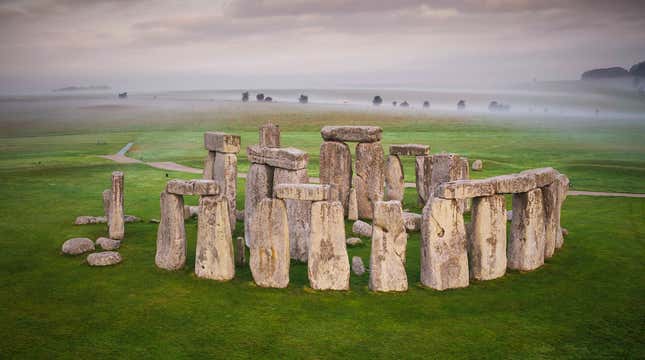
The origin of the largest stones used to build Stonehenge has been a matter of considerable debate for centuries, but a new chemical analysis of these boulders may have finally settled the issue once and for all.
West Woods in Britain’s Wiltshire county has been identified as the primary source location of the large sarsen boulders found at Stonehenge, according to new research published today in Science Advances. A geochemical analysis shows that 96% of the sarsens at Stonehenge originated from West Woods, a plateau 15.5 miles (25 kilometers) north of the monument.
The study, led by geologist David Nash from the University of Brighton, dispels traditional theories about these rocks and where they were sourced, while painting a clearer picture of the route taken to transport these gigantic boulders to the Neolithic site.
The origin of the smaller bluestones located near the interior of Stonehenge was previously traced to Wales, some 140 miles (225 km) from the megalithic structure. As for the larger boulders, known as sarsens (or more technically duricrust silcrete), that has remained a matter of dispute. Today, 52 of approximately 80 original sarsens remain at Stonehenge, the largest of which reach 30 feet tall (9 meters) and weigh 25 tons.

A popular theory proposed as early as the 16th century suggests the sarsens originated from Marlborough Downs, a site located 19 miles (30 km) north of Stonehenge and slightly north of West Woods on the opposite side of the Kennet river. This conception is “rarely challenged and has never been rigorously tested,” wrote the authors in the new paper.
Using a portable X-ray fluorescence spectrometer, Nash and his colleagues performed non-invasive scans of all upright and horizontal sarsen stones at Stonehenge. This allowed them to determine the chemical composition of the boulders. Then, a core sample taken from one of the sarsens in 1958, Stone 58, was analyzed with a mass spectrometer and compared to other sarsens found across southern Britain. As the authors note in the study, this generated “high-resolution chemical signatures for the monument and potential source regions.”
A statistical analysis of this data showed that 50 of the 52 sarsens at Stonehenge share a chemical signature with stones found at a common source area, namely West Woods.
“Until recently we did not know it was possible to provenance a stone like sarsen,” said Nash in an AAAS press release. “It has been really exciting to use 21st-century science to understand the Neolithic past and answer a question that archaeologists have been debating for centuries.”

That West Woods is the origin of the sarsens is entirely plausible. People have lived on this 2.3-square-mile (6-square-km) plateau since the Mesolithic period, at least 8,000 years ago. The area was once rich in sarsens, and extraction pits are common.
As to why West Woods was chosen over other locations isn’t entirely clear, but the authors suspect that the size and quality of the stones at this site might have had something to do with it. What’s more, its “topographic position on high ground south of the Kennet [river] and its relative proximity to Salisbury Plain [the location of Stonehenge] would also have made it an efficient place from which to obtain the sarsens,” the authors wrote.
Importantly, the new research suggests the sarsens were sourced and transported to Stonehenge during the same time period, around 2500 BCE, when the monument was going through its second stage of construction.
With the source of the stones established, the scientists mapped probable routes over which they might have been transported to Stonehenge; the Neolithic builders could have transported the stones along a route from West Woods via Knap Hill, or alternatively a route along the White Horse Trail and through the Vale of Pewsey and Avon River (see map).
An open question remains about the two stones not sourced from West Woods, the origin of which could not be determined. Were these stones brought in by a different team of builders or even a different Neolithic community? Could these stones have been sourced in the vicinity of the monument? As the authors wrote, it’s possible that some of the approximately 28 stones missing from Stonehenge and surrounding area “were also derived from these different source areas, but we will probably never know.”
There’s still lots to learn about this impressive monument and the people who constructed it, likely to track the summer solstice and host gigantic festivals. More amazing discoveries surely await.